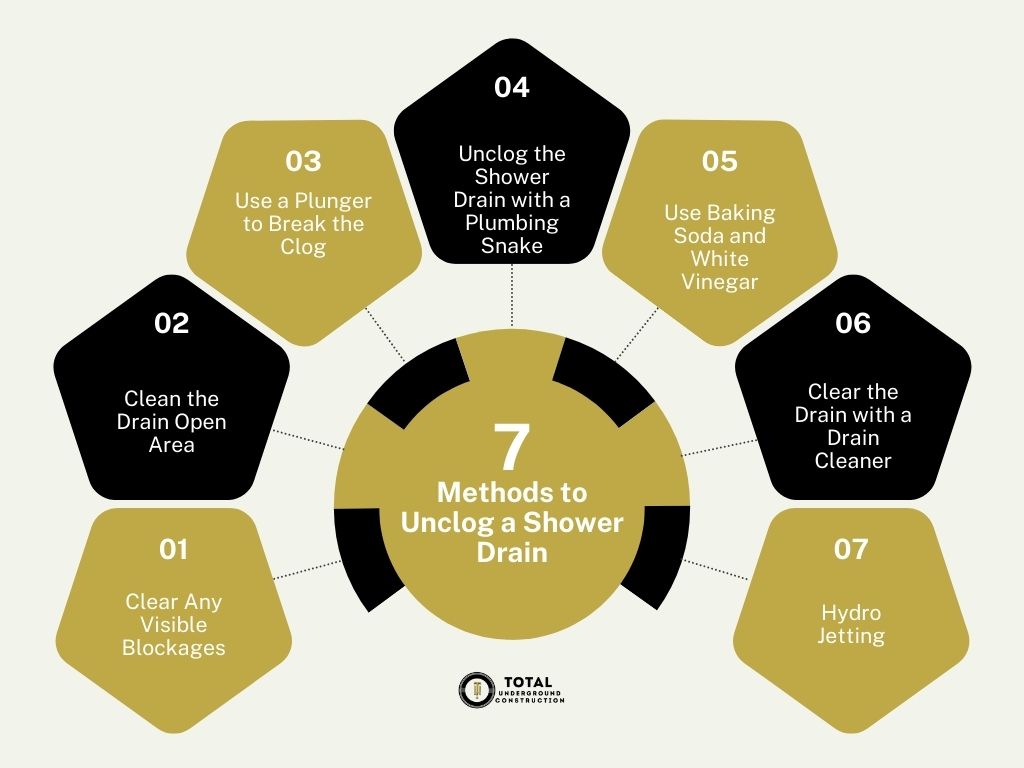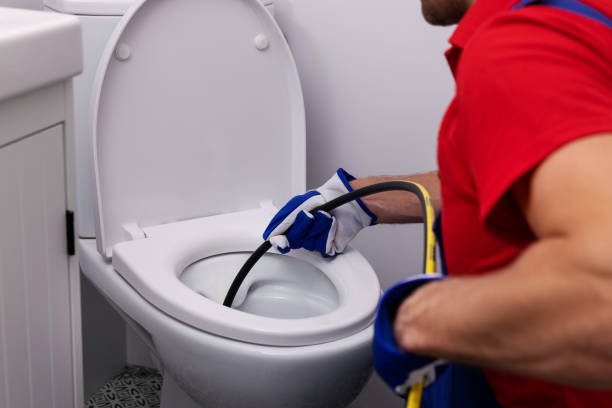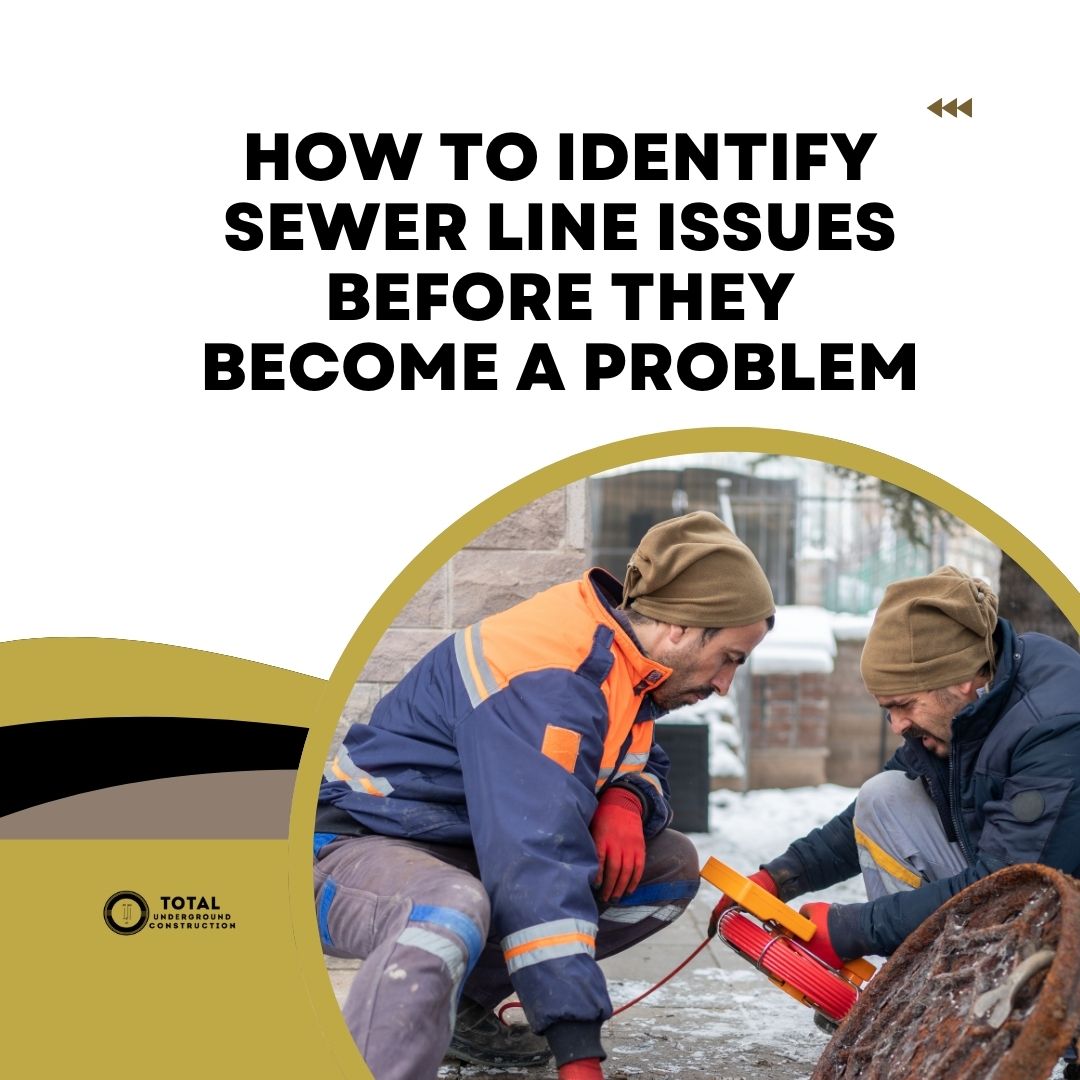Shower drains are prone to clogging, especially if they don’t have a sieve on the drain opening. From soap scum, hair, dirt, debris, mineral deposits, and foreign objects, your open or covered drain can quickly develop foul-smelling blockages that attract flies and cause backup, pipe fissures, and leakages. Learning how to unclog a shower drain can help avoid costly repairs and replacements. Here is an exhaustive list of things you can do to unclog your shower in case of a blockage problem.
7 Proven Ways to Unclog a Shower Drain
Slow-draining water in the shower can be a nightmare, but you don’t need to watch as the water slowly backs up. Let these tips and tricks help you restore flow in your shower drain pipe.

1. Clear Any Visible Blockages
Before stocking your chemical solutions, soaps, and cleaning equipment, you can try to unclog a shower drain without tools. Inspect the drain area for any visible debris, dirt, hairs, or scum. Twist or unscrew the drain cover to see if there is any blockage. Remove the clog. Wear rubber gloves to prevent the transfer of pathogens on your skin.
2. Clean the Drain Open Area
Regular cleaning is one of the easy ways to unclog a shower drain naturally. The gradual accumulation and solidification of soap scum, head and body hairs, dirt, and debris can clog the opening of the drain interfering with water flow. You can prevent this by regularly cleaning the drain opening after a shower. Have a floor brush and all-purpose cleaner in the bathroom for a quick rise after a shower to prevent scum and dirt from percolating in your floors and drain.
3. Use a Plunger to Break the Clog
Plungers are effective for breaking simple blockages typical in a shower drain. Unclogging a shower drain with a plunger is straightforward. Place the plunger on the shower drain opening, creating a tight seal. Push the plunger rhythmically to create pressure variations between the drain and the surrounding areas. The resulting force is enough to dislodge a clog or break it apart, restoring wastewater flow inside the drain.
4. Unclog the Shower Drain with a Plumbing Snake

A plumbing snake is a long and coiled flexible metal that can pull out or dismantle gunk deep in the shower drain gunk. The technique is not for the faint-hearted because you have to bear with waste from the drain. Here is a step-by-step guide on how to unclog a shower drain with a snake:
- Start by prepping the bathroom with garbage bags or towels because this technique is messy and smelly. Wear protective clothing in case of any spillage.
- Remove and clean the p-traps or arm traps and clean them.
- Insert the plumbing snake without applying too much pressure to preserve the integrity of your drain line’s structure.
- Gently rotate the snake as you push up and down inside the drain.
- Remove the retrieved gunk and throw them in a trash bag.
- Turn on the shower to confirm the drain line is clear of the blockage.
5. Use Baking Soda and White Vinegar
Another tried-and-true way to unclog minor blockages is to use a concoction of hot water, baking soda, and white vinegar.
- Mix half a cup of baking soda with a quarter cup of salt and pour it down the drain.
- Then, empty half a cup of white vinegar down the drain.
- Wait for the reaction to fizzle out—between 15 and 30 minutes. The baking soda and vinegar mixture produces carbon dioxide gas, which adds to the pipe’s internal pressure and breaks the solidified clog. The longer the waiting period, the better the results.
- Finish by pouring hot water down the drain. Hot water disintegrates the clog further, melts scum, and kills germs. You can finish the process with a plunger to remove every debris.
6. Clear the Drain with a Drain Cleaner
Chemical drain cleaners can clear hair and grease to complex blockages in your shower drains. The cleaning agents use strong acids or alkalis. Some contain caustic substances like sodium hydroxide and potassium hydroxide as the active ingredient. The chemicals break down FOGs in clogs, breaking the solid.
Other drain cleaners use enzymes to degrade organic matter. On the other hand, some have oxidizers like hydrogen peroxide, which act on the clog through oxidation. Always use protective gear when handling drain cleaners because the chemicals are corrosive to the skin, eyes, and respiratory tract.
Using a drain cleaner is much simpler than the plumbing snake technique. Pour the chemical down the drain and wait for it to work on the clog. To maximize efficiency, follow the manufacturer’s guide on handling the chemical and the wait time. Finish the process by pouring hot water down the drain.
7. Hydro Jetting

If all else has failed, it may be time to try a professional unclogging technique. Stubborn clogs, such as tree roots or strange objects down the shower drain or a backup due to clogging in the main sewer line, require high pressure to destroy. The hydro jetting technique requires a professional plumber for several reasons.
The hydrojet uses immense water pressure ranging between 2000 psi and 60,000 psi. Plumbers conduct trenchless inspections to determine the clog’s nature, its position in the drain, and the ability of your plumbing infrastructure to handle the incoming water pressure. Hydro jets can dislodge all kinds of clogs in drain and sewer pipes.
Frequently Asked Questions on How to Unclog a Shower Drain
How do you plunge a shower drain?
First, place the plunger over the shower drain to create an airtight seal. then, push down the plunger with rhythmic movements to vary pressure inside the drain, which dislodges the blockage. Run some hot water to flush down any debris and repeat the process until the clog is gone.
What is the best drain cleaner for showers?
Baking soda and vinegar work best for organic matter and scum. Enzyme drain cleaners or chemical-based agents (sodium hydroxide, hydrogen peroxide) work better for soap scum and grease. However, the best cleaner depends on the type of clog.
Hire Professional Plumbers Today
We understand the frustration and inconvenience of a blocked shower drain, which can interfere with your routine. If your shower clog persists after you try the DIY unclogging techniques mentioned, hiring a professional plumber in Texas is the best decision. Call us today for professional advice, emergency plumbing services, or a routine shower inspection.




